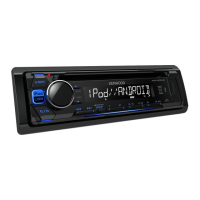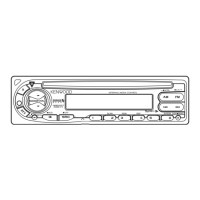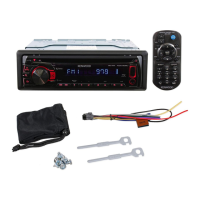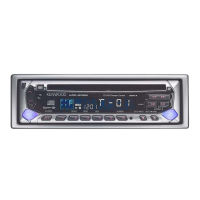Why does “NA FILE” appear on my Kenwood KDC-200U?
- ZZachary JohnsonSep 5, 2025
The “NA FILE” message on your Kenwood Car Receiver indicates that the unit is trying to play an unsupported audio file.

Why does “NA FILE” appear on my Kenwood KDC-200U?
The “NA FILE” message on your Kenwood Car Receiver indicates that the unit is trying to play an unsupported audio file.
Why does “COPY PRO” appear on my Kenwood Car Receiver?
The “COPY PRO” message on your Kenwood Car Receiver indicates that a copy-protected file is being played.
Why does “NO MUSIC” appear on my Kenwood Car Receiver?
The “NO MUSIC” message on your Kenwood Car Receiver means that the connected USB device contains no playable audio file.
Why don't tracks play back as intended on my Kenwood KDC-200U Car Receiver?
If tracks on your Kenwood Car Receiver are not playing back in the order you expect, it's because the playback order is determined when the files are recorded.
Why is elapsed playing time incorrect on my Kenwood KDC-200U?
If the elapsed playing time is not correct on your Kenwood Car Receiver, this is caused by how the tracks are recorded.
Why does “READING” keep flashing on my Kenwood KDC-200U?
The flashing “READING” message on your Kenwood Car Receiver indicates that a longer readout time is required. Also, avoid using too many hierarchies and folders.
| Tuner | AM/FM |
|---|---|
| CD Playback | Yes |
| USB Input | Yes |
| Bluetooth | No |
| Aux Input | Yes |
| Display Type | LCD |
| Preout Voltage | 2.5V |
| MP3 Playback | Yes |
| WMA Playback | Yes |
| FLAC Playback | No |
| Detachable Faceplate | Yes |
| Channels | 4 |
| AAC Playback | No |
| Remote Control | Optional |
| Preset EQ | Yes |
| Power Output | 50W x 4 |
| Preamp Outputs | 2 |
| RMS Power Output | 22W x 4 |
Essential safety guidelines for operation, handling, and electrical safety.
Instructions for cleaning the unit, its connectors, and proper handling of discs.
Instructions for attaching and detaching the detachable faceplate.
Steps to restore the unit to its default factory settings.
Preparing the remote controller for first-time use and battery replacement.
Special handling notice for products sold in California regarding perchlorate.
Important cautions regarding the lithium battery in the remote control.
Overview of the main unit's controls and the remote controller.
Steps to turn the unit on, off, and switch between sources.
Explanation of what various indicator lights signify.
Detailed explanation of how various buttons on the unit and remote operate.
How to turn off the automatic display demonstration mode.
Instructions to enable or disable the unit's demonstration mode.
Step-by-step guide to set the current time on the unit.
Steps to enter and configure initial unit settings.
Details on selectable settings like Preset Type and Key Beep.
Information on using KENWOOD Music Editor Light and Music Control applications.
How to select the TUNER source and switch between FM/AM bands.
Configuring SEEK MODE, AUTO MEMORY, and MONO SET for radio.
Entering specific frequencies using the remote controller for tuning.
Using buttons to search for stations and select preset stations.
Instructions for inserting and playing CDs.
How to connect a USB drive for audio playback.
Steps for connecting an iPod or iPhone for music playback.
Details on discs that cannot be played by the unit.
How to set repeat playback and random (shuffle) modes.
Selecting specific folders, tracks, or files for playback.
Searching for music tracks using the remote's number buttons.
Important information regarding USB device compatibility and connection.
How to search for songs by typing characters alphabetically.
Switching between controlling iPod from the unit or the device itself.
Adjusting the ratio for skipping songs during searches.
Details on supported iPod and iPhone models and compatibility lists.
Enabling the Pandora source in the unit's settings.
Connecting a device and starting Pandora streaming.
Navigating and selecting stations within the Pandora app.
Using the remote for playback control and station search.
Requirements, US availability, and support for the Pandora service.
Enabling the built-in AUX input for external audio devices.
Steps to connect and play audio from portable devices via AUX.
Adjusting settings like Subwoofer level and Bass/Mid/Treble.
Detailed settings for EQ, Bass Boost, Loudness, Balance, Fader, Subwoofer, and Volume Offset.
Options for AUX naming, Clock adjustment, Display dimming, and Text scrolling.
Resolving problems like no sound, 'PROTECT' message, or unit not powering on.
Solutions for poor radio reception, CD errors, and playback interruptions.
Addressing common errors related to USB devices and unsupported files.
Resolving specific errors and issues related to iPod and Pandora.
Addressing problems with playback timing, character display, and reading status.
List of parts required for installing the unit in a vehicle.
General steps for physically installing the unit.
Crucial safety warnings to follow during installation.
Important cautions and tips for a successful installation.
Detailed diagram and explanation of all electrical wiring connections.
Step-by-step instructions for mounting the unit in the dashboard.
How to safely detach the unit from the vehicle's dashboard.
Technical details for FM/AM tuner and CD player sections.
Specifications for USB interface and audio output.
Details for auxiliary input, operating voltage, dimensions, and weight.
Information on supported audio file formats and disc media types.
Warnings about radiation exposure and proper usage.
Details on FCC regulations, warnings, and interference correction.
Information on 'Made for iPod/iPhone', Pandora, and Android trademarks.












